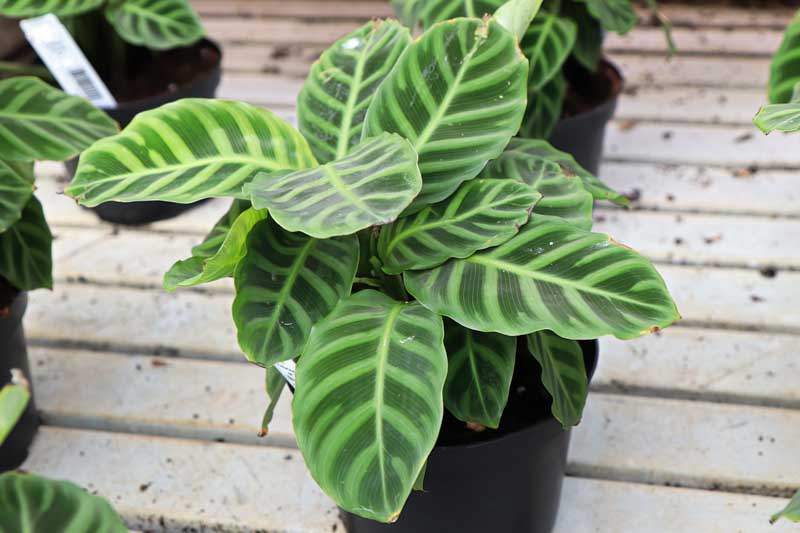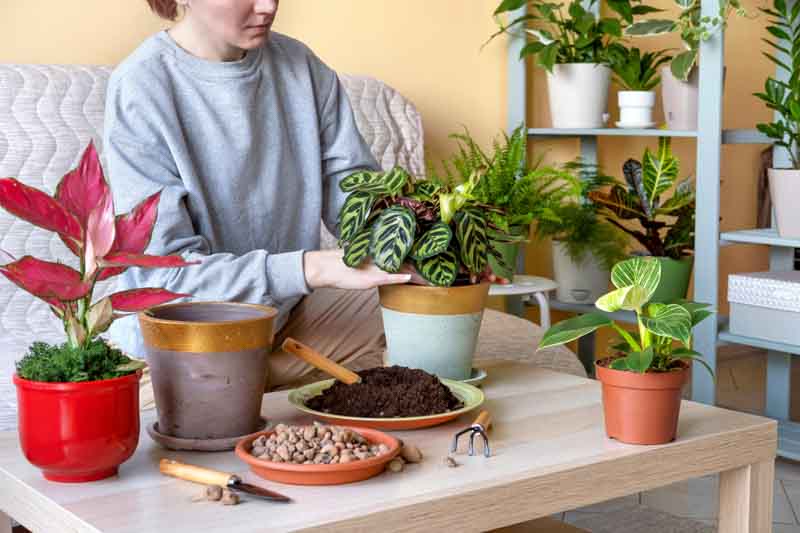Zebra Plant, Goeppertia zebrina
The Calathea zebrina, commonly known as the Zebra plant, is a captivating species cherished for its unique and striking foliage, making it a popular choice among houseplant enthusiasts. This species, formerly assigned to Calathea, is now in the genus Goeppertia.
Calathea zebrina is distinguished by its large, velvety leaves that are a deep green color with distinctive zebra-like stripes of a lighter green. Its leaves are broad and elongated, extending from the central stem on long petioles.
Native: This species originates from the tropical rainforests of Brazil, where it thrives under the canopy in moist, warm conditions, making it well-suited to indoor environments that mimic these conditions. The Zebra Plant belongs to the arrowroot family (Marantaceae) along with the Prayer Plant.
Plant Type and Habit: Calathea zebrina is a compact, rhizomatous, evergreen perennial with a clumping habit, growing upright with leaves that spread outwards, creating a lush, full appearance.
Size: Typically, Calathea zebrina can reach heights of 1 to 3 feet (30 to 90 cm) and a spread of 1-2 feet (30-60 cm), depending on the pot size and growing conditions.
Flowers: Although it is primarily grown for its foliage, Calathea zebrina can produce spikes of small, inconspicuous white or purple flowers in its natural habitat, which rarely occur when grown indoors.
Foliage: The foliage is the most notable feature, with leaves, up to 12” long, that rise from basal rosettes on long petioles, forming a clump. Velvety dark green with chartreuse zebra-like stripes along veins and reddish-purple undersides. At dusk, leaves fold like praying hands, earning sometimes the “prayer plant” name.
Hardiness: Calathea zebrina is hardy in USDA zones 11-12. It is not frost-tolerant and must be kept in environments above 60°F (15°C) to thrive.
Award: Recipient of the prestigious Award of Garden Merit of the Royal Horticultural Society.
Uses: Primarily used as an ornamental houseplant, it is also popular in offices and commercial spaces for its air-purifying qualities and the vibrant greenery it adds to indoor settings.
Toxicity: It is non-toxic to cats, dogs, and humans, making it a safe choice for pet owners and families. Its sap may irritate sensitive skin.
Benefits: Beyond its ornamental value, it helps purify the air by removing toxins. It also increases indoor humidity, which can be beneficial for respiratory health and overall well-being.

Caring for a Zebra Plant involves meeting specific requirements to ensure it thrives.
Light: Calathea zebrina prefers filtered light and should be sheltered from strong winds and extreme temperatures if placed outdoors. Indoors, avoid direct sunlight as it can scorch the leaves. It thrives in indirect sunlight or diffused light, making locations like bathrooms ideal due to higher humidity levels.
Soil: A peat-based mix, combining two parts peat with one part perlite, is ideal. Alternatively, an African Violet potting mix or a blend of garden soil, perlite, or sand with peat works well.
Water: Keep the soil consistently moist but well-drained. Overwatering can lead to root rot, so ensure the pot has adequate drainage. Reduce watering in winter, allowing the topsoil to dry out between waterings. Use room temperature water to avoid shocking the plant.
Temperature and Humidity: Maintain indoor temperatures between 65 to 75°F (18 to 24°C), ensuring it does not drop below 60°F (15°C). Avoid temperature fluctuations and drafts.
High humidity is crucial for the plant’s health. Use a humidifier, mist the plant, or place it near other plants to create a humid microclimate. Avoid spraying water directly on the leaves.
Fertilization: Fertilize with a balanced liquid fertilizer monthly during the growing season (April to October). Avoid fertilizing in winter when the plant’s growth slows down.
Pruning: Prune only damaged or infected stalks or leaves. Avoid pruning healthy parts of the plant.
Repotting: Repot every two years in spring or when the plant outgrows its pot (the plant becomes root bound or roots come out of the drainage holes).
Propagating Calathea zebrina effectively involves division, as this method works best for these types of plants.
Choose the Right Time: The best time for propagation is in late spring when the plant is in its active growth phase.
Prepare Your Tools and Workspace: Ensure you have clean, sharp scissors or a knife, pots for the new plants, and appropriate potting mix (peat-based or similar to what the parent plant is in). Sterilize your tools with rubbing alcohol or a bleach solution to prevent the spread of disease.
Remove the Plant from Its Pot: Carefully take the Calathea zebrina out of its pot. You may need to tap the pot’s sides or gently pull the plant by the base to ease it out.
Inspect and Separate the Rhizomes: Look for natural divisions in the root ball where the plant has formed distinct clumps or sections. These are your propagation points. Gently tease the roots apart with your fingers or cut through them with your clean, sharp tool if necessary. Ensure each division has a good amount of roots and at least one or two shoots (leaves).
Pot Up the Divisions: Fill your new pots with a suitable potting mix, making a hole in the center for the division. Place each division in its pot, ensuring it sits at the same depth as in the original pot. Fill around the roots with more potting mix, gently firming to support the plant.
Water and Care for Your New Plants: Water each new plant thoroughly after potting to settle the soil around the roots and eliminate air pockets. Keep the soil consistently moist but not waterlogged. Place the new plants in a warm, humid spot with indirect light, similar to the parent plant’s preferred conditions.
Monitor and Maintain Humidity: To ensure high humidity, you can cover the pots with plastic bags to create a greenhouse effect. Ensure to open the bag daily for fresh air and check the soil moisture.
Be Patient: Growth may be slow initially as the plant adjusts and develops new roots and foliage. It can take several weeks to see significant growth.

Zebra Plants are relatively resistant to major problems, but like all indoor plants, they can encounter some pests, diseases, and common issues.
Spider Mites: These tiny pests can be identified by the fine webs they weave on the plant. They cause yellowing or speckled leaves. Increase humidity around the plant and wash it with a strong stream of water. For severe infestations, use insecticidal soap or neem oil.
Mealybugs: These white, cottony pests tend to cluster in leaf axils and under leaves, sucking sap and weakening the plant. Remove with alcohol-dipped cotton swabs or apply neem oil.
Aphids: Small, soft-bodied insects that can be green, black, brown, or pink, aphids typically feed in groups on the undersides of leaves. Combat them with a gentle spray of water, neem oil, or insecticidal soap to protect the plant’s health and appearance.
Scale insects: Hard or soft-bodied insects that attach themselves to the stems or leaves, causing yellowing and growth stunting. Scrape off with a fingernail or use a cotton swab dipped in rubbing alcohol. Insecticidal soap or neem oil may also be used.
Root rot: Often a result of overwatering, leading to brown, mushy roots and wilted leaves. Prevent by ensuring good drainage and letting the soil partially dry between waterings. Affected plants may need repotting with fresh soil after cutting away any rotten roots.
Leaf spot: Fungal or bacterial infections causing spots on leaves. Avoid wetting foliage when watering and improve air circulation. Remove affected leaves and treat with fungicides if necessary.
Brown Leaf Edges: Usually a sign of low humidity or watering with hard water. Increase humidity around the plant and use filtered or distilled water.
Fading Leaf Color: Lack of sufficient light can cause the vibrant patterns to fade. Move your plant to a brighter location with indirect light.
Leaf Curling: Often a sign of under-watering or low humidity. Ensure the soil is consistently moist and increase humidity around the plant.
Drooping Leaves: Can indicate either overwatering or under-watering. Check the soil moisture and adjust your watering schedule accordingly.
| Hardiness |
11 - 12 |
|---|---|
| Plant Type | Houseplants, Perennials |
| Plant Family | Marantaceae |
| Genus | Calathea, Goeppertia |
| Exposure | Partial Sun |
| Season of Interest |
Spring (Early, Mid, Late) Summer (Early, Mid, Late) Fall Winter |
| Height |
1' - 3' (30cm - 90cm) |
| Spread |
1' - 2' (30cm - 60cm) |
| Maintenance | Low |
| Water Needs | Average |
| Soil Type | Loam, Chalk, Clay |
| Soil pH | Acid, Neutral, Alkaline |
| Soil Drainage | Moist but Well-Drained, Well-Drained |
| Characteristics | Showy, Evergreen, Plant of Merit |
| Garden Uses | Patio And Containers |
| Hardiness |
11 - 12 |
|---|---|
| Plant Type | Houseplants, Perennials |
| Plant Family | Marantaceae |
| Genus | Calathea, Goeppertia |
| Exposure | Partial Sun |
| Season of Interest |
Spring (Early, Mid, Late) Summer (Early, Mid, Late) Fall Winter |
| Height |
1' - 3' (30cm - 90cm) |
| Spread |
1' - 2' (30cm - 60cm) |
| Maintenance | Low |
| Water Needs | Average |
| Soil Type | Loam, Chalk, Clay |
| Soil pH | Acid, Neutral, Alkaline |
| Soil Drainage | Moist but Well-Drained, Well-Drained |
| Characteristics | Showy, Evergreen, Plant of Merit |
| Garden Uses | Patio And Containers |
How many Calathea zebrina (Zebra Plant) do I need for my garden?
| Plant | Quantity | |
|---|---|---|
| Calathea zebrina (Zebra Plant) | N/A | Buy Plants |
Create a membership account to save your garden designs and to view them on any device.
Becoming a contributing member of Gardenia is easy and can be done in just a few minutes. If you provide us with your name, email address and the payment of a modest $25 annual membership fee, you will become a full member, enabling you to design and save up to 25 of your garden design ideas.
Join now and start creating your dream garden!
Create a membership account to save your garden designs and to view them on any device.
Becoming a contributing member of Gardenia is easy and can be done in just a few minutes. If you provide us with your name, email address and the payment of a modest $25 annual membership fee, you will become a full member, enabling you to design and save up to 25 of your garden design ideas.
Join now and start creating your dream garden!